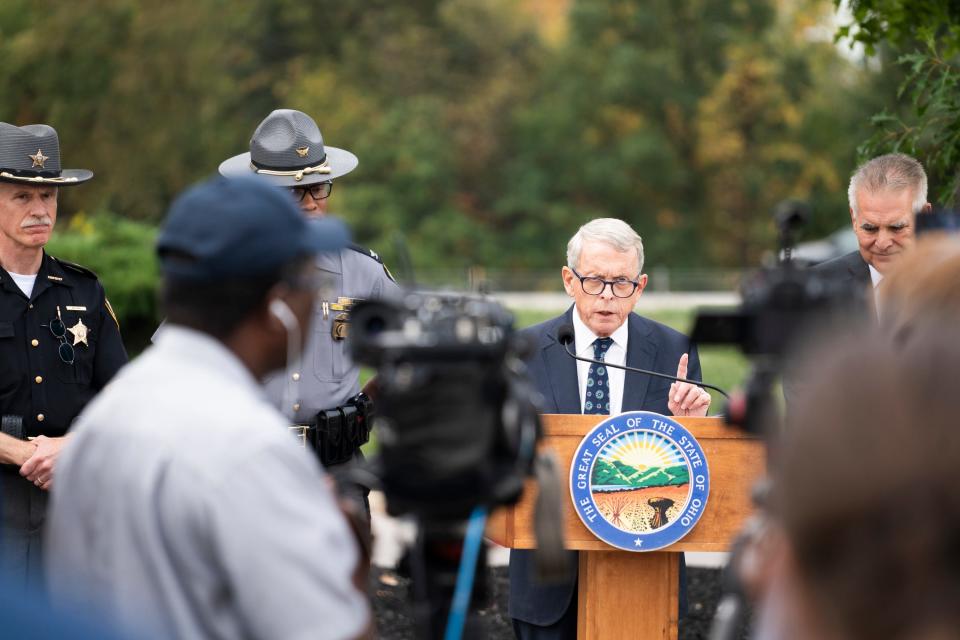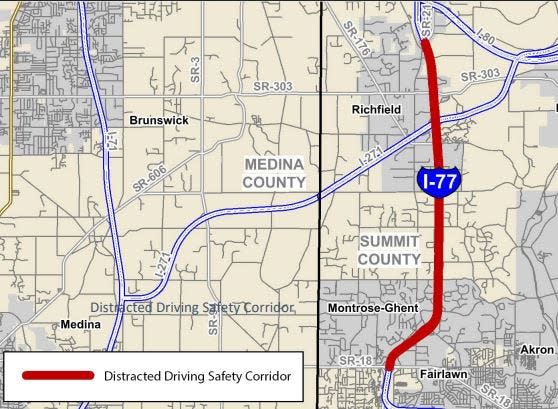Gov. DeWine explains what to expect from Ohio's new distracted driving law
![Ohio State Trooper Captain William Haymaker talk about the new Distracted Driving Law during an afternoon press conference at the I-77 North rest area on Thursday, Oct. 5, 2023, in Bath Township, Ohio. [Phil Masturzo/ Beacon Journal]](https://s.yimg.com/ny/api/res/1.2/ptoctiEhpe2D7aPtZ8k5Dg--/YXBwaWQ9aGlnaGxhbmRlcjt3PTEyNDI7aD04NTM-/https://media.zenfs.com/en/akron-beacon-journal/d082d5e2f9beeeaffb461f5f28b306a6)
- Oops!Something went wrong.Please try again later.
Ohio law enforcement can now immediately ticket drivers for distracted driving under a new law involving cell phones and other electronic devices. On some stretches of highway, they're going to be looking more closely for violators.
"We truly feel that this law has been a long time coming," said Ohio State Highway Patrol Capt. William Haymaker, commander of the patrol's Cleveland district, at Thursday's announcement.
Haymaker made the announcement during a press conference at a rest area off of Summit County's new Distracted Driving Safety Corridor, an 8-mile stretch of Interstate 77 from Route 18 in Montrose to the Brecksville Road interchange in Richfield.
While the new law is effective on all roads in Ohio, there are currently 16 specific stretches of highway scattered across the state where enforcement efforts involving distracted driving and speeding will be a priority.

"Beginning today, if law enforcement sees a driver distracted by their phone, that driver can now be immediately pulled over," Ohio Gov. Mike DeWine said Thursday to explain the new distracted driving law at an event near another corridor I-71 in Sunbury outside Columbus.
This week marks six months since Ohio’s new distracted driving law involving cell phones and other devices took effect. While distracted driving has been a violation for years, the new law makes it a primary offense, meaning law enforcement can immediately stop a driver if they see a violation.
Police have only been issuing warnings for distracted driving under the new law during the six-month grace period.
More: Distracted drivers cited more often in 2020; turnpike targeted for enforcement in Summit County
Dangerous stretch of road
ODOT Highway Technician Fred Turpin, who has been on the department for 23 years, said he worked most of his career without incident until he was struck from behind twice by distracted drivers who hit his work trucks. The first incident was in July 2022 while driving a support truck on I-77 in Cleveland, and the second was in January on Interstate 480 near the Cleveland-Hopkins airport.
While he declined to talk about his injuries, Turpin said he's pleased with the new law.
"I think the distracted driving has gotten way out of control. More people are doing more with their phones with texting, video calls, video chatting. It's more now than it has ever been. That's what I'm seeing," he said.

According to ODOT, the 8-mile section of I-77 north of Route 18 gained attention for its 755 crashes between 2019 and 2022, which resulted in 198 injuries and four fatalities.
The signs marking the corridor were relocated from the previous Distracted Driving Safety Corridor on I-77 between Faircrest Street and Wise Road in Stark and Summit counties. During the two years the previous corridor was enforced, crashes decreased by 6%, and fatal and injury crashes decreased by 13%, according to ODOT. In that time, police issued 165 distracted driving violations.
What can get you pulled over?
"Police officers and troopers no longer must wait until that individual committed a separate offense to be able to pull them over," DeWine said about distracted drivers.
Motorists may now receive a citation from Ohio law enforcement if they are observed using, holding or physically supporting, with any part of their body, an electronic wireless communications device while driving.
More: Penalties for Ohio’s distracted driving law start Thursday. Here’s what you need to know
“Electronic wireless communications devices” include:
Wireless phones
Text-messaging devices
Personal digital assistants
Computers, including laptops or tablets
Devices capable of displaying a video, movie, broadcast television image or visual image
Other substantially similar wireless devices that are designed or used to communicate text, initiate or receive communication, or exchange information or data
Specific exemptions included
There are some important exceptions to the law.
Drivers over 18 can listen to audio streaming apps and use navigational equipment if they turn them on before getting on the road or use a single touch or swipe to activate, modify, or deactivate them.
Adult drivers are not if violation if their use is "hands free" via their vehicle's Bluetooth or other system. They may also hold a phone to their ear during phone conversations, but only if the call is started or stopped with a single touch or swipe. Phones may not be held or supported by any other part of the body during such use, including use of speakerphone features.
Drivers may also use cell phones and other electronic devices while stopped at a traffic light.
Other exceptions include reporting emergency situations and for emergency personnel such as first responders, utility workers in performance of their duties, licensed amateur radio operators and commercial truck drivers using mobile data terminals.
A website detailing information on the law is at phonesdown.ohio.gov.
What are the penalties?
The penalties include:
A fine of up to $150 and two points on your license for the first offense.
A fine of up to $250 and three points on your license for a second offense within two years.
A fine of up to $500, four points on your license and a 90-day driver's license suspension for a third offense within two years.
Fines are doubled for those who use cellphones while driving in a work zone.
What will enforcement look like?
DeWine said local law enforcement and the Ohio State Highway Patrol will have zero tolerance for those who drive distracted, and troopers are now launching multiple new high-visibility enforcement efforts to watch for violation of the law.
Col. Charles Jones of the OSHP said troopers will make distracted driving a priority, and before issuing a citation, troopers or law enforcement officers will make sure they have all the elements needed for the offense.
"[Troopers] have to be able to go into court and be able to prove that that offense and violation did indeed occur," Jones said. "Our troopers know that. They know what metrics they need to hit to be able to prove that that motorist indeed committed that offense."
The elements, Jones said, are what's in the law.
"We know what drivers can and cannot do, and it's up to the troopers or the law enforcement officers to prove that indeed what they saw or they observed was indeed what happened," Jones said.
If need be, troopers or law enforcement officers can testify in court about the specific violations.
Five years ago: Light penalties await most caught texting while driving
How can law enforcement tell if it was 'one swipe or touch?'
"When you've been driving down the road at some point, you've seen a car swerving, not driving in their lane, not doing what they should be doing, and when you pull up next to that car, you pass that car, you see somebody holding a phone up, watching a movie, doing something that they shouldn't be doing, paying attention to that phone," said Andy Wilson, director of the Ohio Department of Public Safety.
This is what troopers and officers will be looking for.
"If you're holding that phone, and you're watching that video, you clearly didn't one-swipe," Wilson said.
![Interstate 77 North is part of a distracted driving corridor that stretches 8 miles North of Ghent Road on Thursday, Oct. 5, 2023, in Bath Township, Ohio. [Phil Masturzo/ Beacon Journal]](https://s.yimg.com/ny/api/res/1.2/nKttQNSiCESdEBhFt8Sy6Q--/YXBwaWQ9aGlnaGxhbmRlcjt3PTk2MDtoPTU5NA--/https://media.zenfs.com/en/akron-beacon-journal/7ee0965179b65cabf769c50ade04bf22)
Could the law experience any adjustments?
DeWine wants to see how the law plays out and then determine if there's anything that's not working or any inequities.
"We're going to look at this one just like how we look at anything else that has passed," DeWine said.
The experience of motorists, troopers and other agencies will give an indication if there are any changes that need to be made in the law, Dewine said. He said the success of the law isn't measured by how many tickets have been issued, but by how many lives have been saved and if the amount of crashes have decreased.
A new media campaign
Ohioans can expect to see on-air and social media advertisements that will encourage them to put their phones down when driving.
More: Details on Ohio's new distracted driving law
The campaign is focused on changing behavior and raising awareness.
In the next few weeks and months, Ohio's Traffic Safety Office will be working with 45 safe community programs across the state to spread the word and inform drivers of the risks that come with distracted driving. The community-based programs work through collaboration with state, county and local partners.
Kayla Bennett is a fellow in the E.W. Scripps School of Journalism's Statehouse News Bureau. Eric Marotta can be reached at emarotta@gannett.com.
This article originally appeared on The Columbus Dispatch: What to expect from Ohio's new distracted driving law, I-77 enforcement

